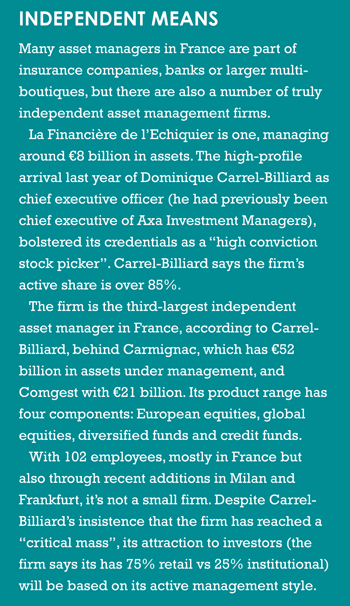French fund investors have been returning to the market after seven years away. The nation’s asset managers are relieved and in expansion mode. David Stevenson reports.
Times are changing in France, a major European market for asset management. In recent times the country has been plagued with problems, such as liquidity issues, which have led to major outflows from funds.
But as Amundi chair Yves Perrier says, this year is the first time France has been “in the green” since 2008. Customers who had previously been moving into life insurance products are returning to funds.
French asset management is rediscovering its joie de vivre.
The French market is renowned for being incredibly competitive, which can make it difficult for new firms to make their presence felt. Size matters in France: distributors would rather deal with fewer, larger asset managers then a wide array of boutique-type firms.
France is a major base for large, multi-boutique houses, notably BNP Paribas Investment Partners and Natixis Global Asset Management (NGAM). So smaller, specialised players do have a chance if they can find a fit within a larger house.
This year, for example, NGAM bought a 70% stake in DNCA, a French firm that has €17 billion of assets under management in European equities and other assets. Similarly, CPR is a wholly owned subsidiary of Amundi and runs thematic funds.
“DNCA has something that is very complicated and is not impacted by market direction,” says Pierre Servant, chief executive of NGAM.
HUMBLE BEGINNINGS
DNCA was launched in 2000. In 2002 a new shareholder – Jean Charles Meriaux – joined, with a record of success in managing European equities. From fairly humble beginnings, the firm now manages €17 billion in assets – not bad for a team of just 76.
According to its chief executive officer, Eric Franc, DNCA has almost a third of its assets in Italy since Banco Leonardo took a 34% stake in the firm in 2006. Last year the firm was second only to Amundi in terms of fund inflows, receiving €5 billion in additional assets.
“Part of the success is due to outperformance of the market and being able to attract new talent,” says Franc.
It is hoped that the NGAM deal will make it easier for DNCA to attract international talent and enter other markets, the priorities being Switzerland and Spain.
Another of Servant’s acquisitions was Ossiam, one of France’s pioneers in smart beta exchange-traded funds (ETFs).
“We would not be where we are without Pierre [Servant] from NGAM,” says Bruno Poulin, chief executive officer of Ossiam. “He knew that something had to be adjusted in mutual funds. He’s the one who makes us alive and kicking as he understood the market would change.”
The firm, which started in 2009, launched its first product in 2011 when it was acquired by NGAM. The firm is slightly wary of the term ‘smart beta’ as it does not want to suggest outperformance of the market. But for Servant’s part, he does not view Ossiam as passive, saying it does distinctive things, such as using quant strategies, and is in no way “plain vanilla”.
As a firm, Ossiam is moving away from products that use an exchange-traded fund (ETF) wrapper. It is beginning to target institutional investors, such as pension funds, that ask “very technical questions” and want mandated funds, not ETFs.
For Servant, having a multi-boutique asset management firm is “not an easy game”, although NGAM’s model is a major asset, he says.
“The industry is polarising between passive cheap beta and totally distinctive expertise on the other side,” he says.
Most of NGAM’s business is outside France. To many, investing in a US distribution network in 2009 seemed like a strange move, but it has since paid off. Like Perrier at Amundi, though, Servant is more bullish on the French retail market than a year ago, as clients are beginning to look at funds again following an improvement in liquidity.
Despite the pick-up in the retail market, Servant is not keen on business-to-consumer technology as a means of progressing his business, though he says this may work for low-margin ETF providers.
NGAM is fielding more enquiries about asset allocation and last year made 400 investment suggestions to independent financial advisers. This surge in asset allocation advice is, according to Servant, due to the state of the markets.
“[Investment managers] want more alternatives that aren’t sensitive to market direction, so they are working a lot on their asset allocation and using our services,” he says.
Plans exist for more acquisitions. “Sometimes I feel like a football coach as I manage egos,” adds Servant, reflecting on his business’s growing headcount.
BANKS’ ASSET MANAGERS
For its part, Amundi has been one the major success stories of French asset management. Founding shareholders Societe Generale and Credit Agricole launched Amundi in 2010 with €650 billion in assets under management; in June this year, the firm had around €950 billion.
Given its success, the firm is preparing an initial public offering (IPO) in France soon. According to Perrier, the decision to list has been on the agenda since its launch. The idea was that Amundi, despite its two bank founders, would not be like other bank-owned captive asset managers, which are a hallmark of the French market.
“Even in the difficult context of the French market, which is the worst market, [the IPO] will accelerate development,” says Perrier, who is also confident that the listing will give the firm more flexibility when it comes to acquisitions.
When it comes to its relationship with the two bank shareholders, Perrier says that the listing will provide Societe Generale with liquidity if it sells its 20% stake, but that none of the distribution agreements with the bank will be impacted.
“They [Societe Generale] are satisfied with the quality of products and the relationship between the people,” he says.
Until this year, Perrier was quite dismissive of the French market. Notwithstanding the growth in AUM over the past five years, he says the firm has experienced outflows from funds totalling €50 billion during the same period.
“I am more optimistic for the French market than I was two years ago,” he says. This is due to a variety of factors, including the monetary policy of the European Central Bank, which is improving liquidity, and market conditions that are causing investors to ask for better risk/reward ratios, which funds can offer.
 Amundi has a split between retail and institutional clients, with the former accounting for around €250 billion of the firm’s AUM. Retail clients have a demand for diversified products and although the level of equity within funds is very flexible, “the demand for pure equity is not so great at the present time”. However, retail investors do want protection of their capital, says Perrier. They want “safe money”.
Amundi has a split between retail and institutional clients, with the former accounting for around €250 billion of the firm’s AUM. Retail clients have a demand for diversified products and although the level of equity within funds is very flexible, “the demand for pure equity is not so great at the present time”. However, retail investors do want protection of their capital, says Perrier. They want “safe money”.
Half of Amundi’s 1,000 institutional investors are deemed “core”, with clients ranging as far as Asia. In fact, one trend Perrier has observed is Japanese clients wanting to switch from yen bonds into eurobonds.
Perrier describes the eurozone as Amundi’s first domestic market and Asia as its second. In Japan alone, Amundi manages €30 billion in assets and while Amundi has a presence in South East Asia via Singapore, it has entered other markets – such as Taiwan, India and China – via joint ventures.
“In Europe, we represent all countries. International development is quite young,” says Perrier.
BOLT-ONS
One of Perrier’s key strategies for growing the business is by organic means, though this is not to suggest that acquisitions are not an option. CPR Asset Management, the wholly owned subsidiary of Amundi, has been running all of Amundi’s thematic equity investments since September this year. Giving CPR the thematic ranges was in part due to CPR’s success with the Silver Age product, a strategy related to ageing.
Jean-Eric Mercier, chief executive officer of CPR, says that the benefit of having his firm within Amundi is that it can respond and bring products to the market quickly. Regarding thematic investing, one challenge cited by Mercier is finding products that are large enough and diversified enough to be part of the portfolio of a private consumer.
“[You] don’t want to be part of a fashionable trend or a limited sector which brings risks in concentration,” he says. Distributors had to be convinced of the investment case and Silver Age’s focus on the well-publicised (and growing) ageing demographic has proved to be a success.
Being part of the Amundi group was vital to making Silver Age a global product. From its inception in 2009, it now has €1.2 billion in assets. In 2011 alone, it grew by €30 million.
“The Amundi team presented us to large institutional, sovereign funds who were keen to invest into Silver Age thematic. They had in mind a global version of Silver Age,” says Mercier.
More recently, Amundi acquired the asset management arm of Austrian bank Bawag last year. This deal gave Amundi a physical presence in Austria for the first time. Perrier describes the Austrian market as similar to Switzerland’s, bringing comparable challenges.
Amundi’s 2013 acquisition of Smith Breeden Associates in the US was “to give us an expertise we didn’t have”, says Perrier. This is to say US fixed income. The firm built up its fixed income expertise in Asia last year with the acquisition of the fixed income business of KAF Fund Management through Amundi Malaysia, its wholly owned subsidiary in Kuala Lumpur.
Perrier describes these acquisitions as “strategy specialist acquisitions” and maintains that “organic growth is our criteria and acquisition can never be a substitute”.
Summing up the state of play in Europe, he says: “If I look at the figures over 18 months, all countries are in progress. The Italian market is better than the French market and the German market is good but not exceptional.”
One year on from our last visit to France, the importance of global markets to the major players remains the same; this is the source of the majority of their revenues. But with a little help perhaps from ECB director Mario Draghi, liquidity has poured back into Eurozone markets, including France, bringing with it flows back into domestic funds.
©2015 funds europe





